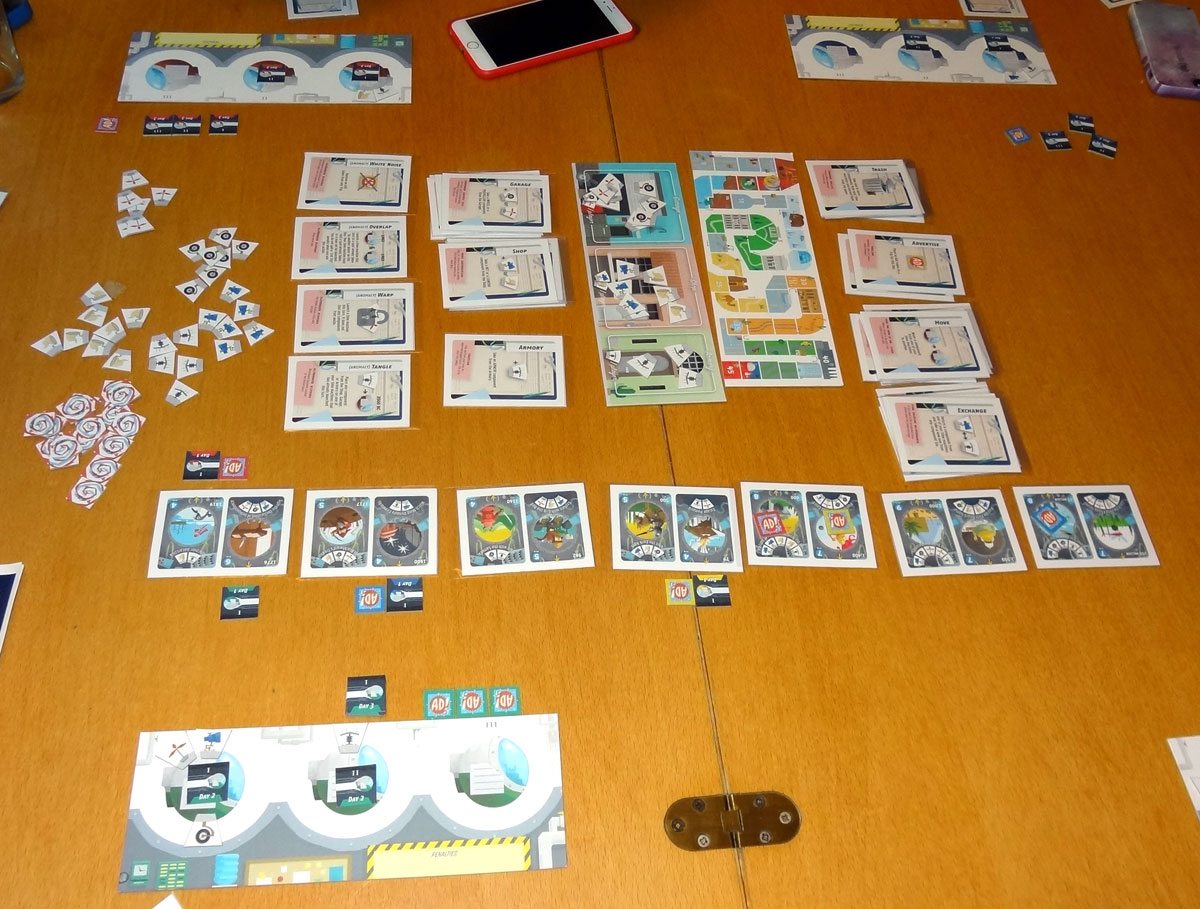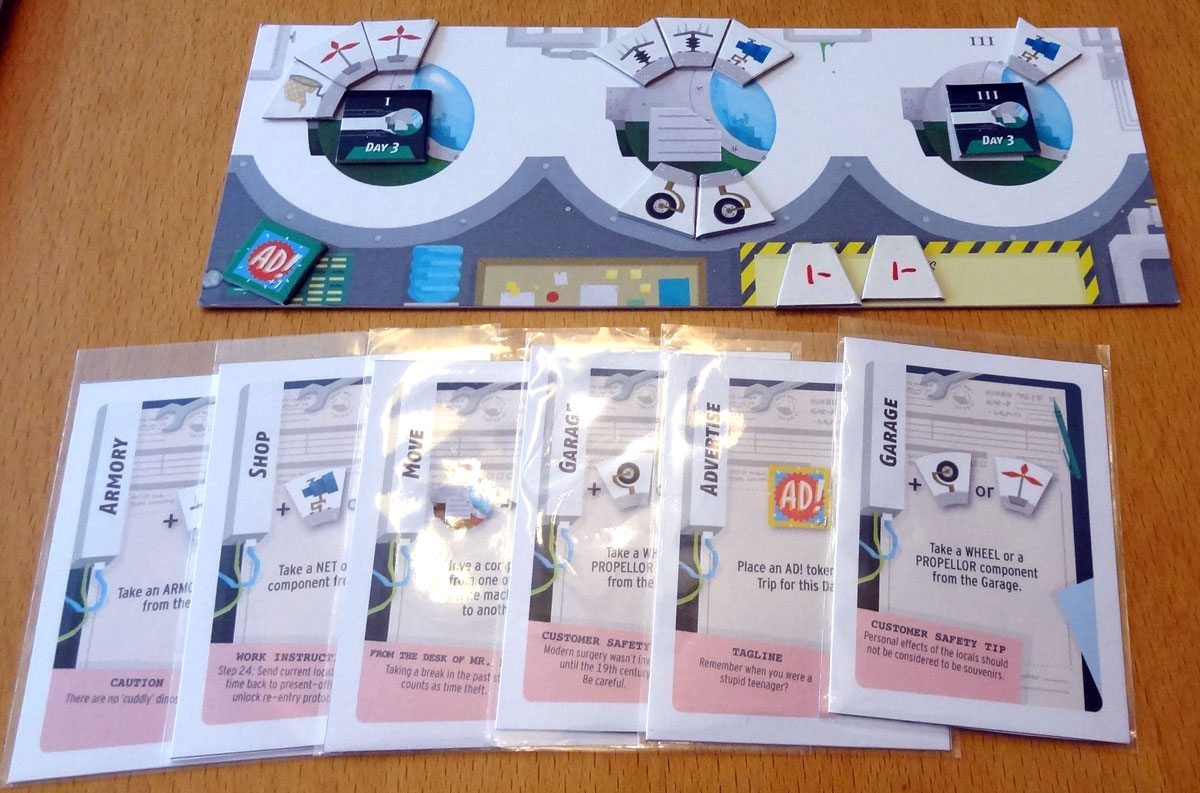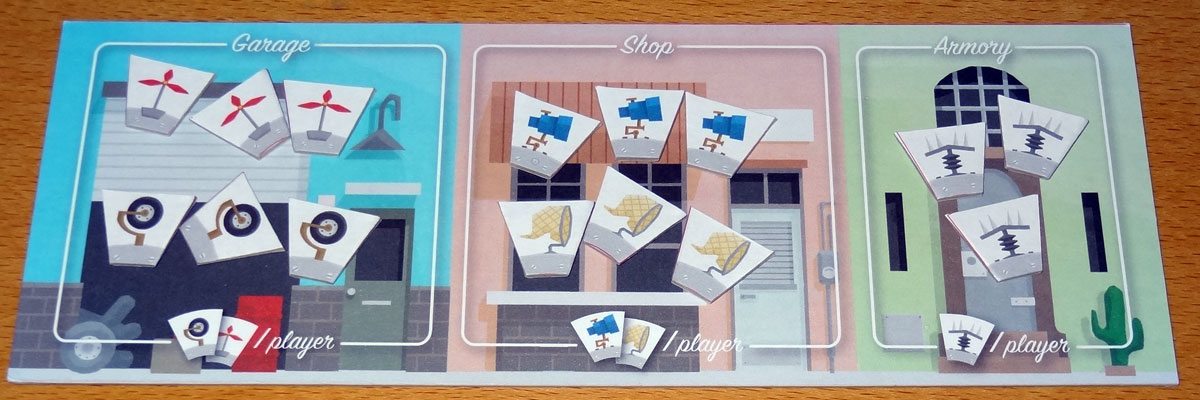Working at a time travel agency isn’t always glamorous, but it has its perks. At the end of the day, if you didn’t hit your numbers, you can just go back and do it again. And at the end of the day, if you didn’t hit your numbers, you can just go back and do it again. And at the end of the day … Welcome to Loop, Inc.
At a glance: Loop, Inc. is a time-travel board game for 2 to 4 players, ages 10 and up, and takes 30-40 minutes to play (unless you actually have a time machine, in which case it takes -20 to 1,500 years). It’s currently on Kickstarter, and a pledge level of $39 (plus shipping outside of the US) will get you a copy of the game. The theme and content are kid-friendly, but it may be a bit complex for less experienced kids, so be sure to check out the gameplay explanation if you’re thinking about playing this with your kids.
New to Kickstarter? Check out our crowdfunding primer.
Components
- 16 Trip cards
- 51 Action cards
- 60 Component tokens (12 each, 5 types)
- 24 Time Machine tokens (6 each per player)
- 4 scoring tokens
- 16 Tear tokens
- 12 Ad tokens
- 4 player boards
- 1 score board
- 1 components board
I received a prototype to try out the game, so the component quality isn’t final, but I think most of the art and graphic design is finished. The artwork is by Kwanchai Moriya, who has also illustrated Rumble in the House and the new edition of Catacombs. I really love his cartoony style.

The scoreboard is cute, but some of the weird shapes can be a little confusing when you’re trying to count spaces. The player boards show three time machines (because by the third time through the day you’ll have three of them), and one thing I really liked was the way the components tokens fit onto the machines.

Each trip card shows two location/times that you can visit, along with the point value and the equipment required to go there. My only complaint was that because the cards are doubled up, the icons on them are pretty tiny and the text is nearly impossible to read at a distance. (The text is just there for flavor, really, but it would be nice to have those be bigger–except then the game would take up a lot more table space, too.)
The action cards all have funny flavor text at the bottom, like alternate history (“Lincoln subdues Booth with a roundhouse kick.”), customer safety tips, company policy (“Tissues will be deducted from your pay.”), and so on.
There are a few additional components that will be added if the stretch goals are funded. As of this writing, there are already 4 additional Anomaly cards and a 5-card “Futures” mini-expansion unlocked.
How to play
You can download a copy of the rules here.
The object of the game is to score the most points by the end of the third “day” by completing profitable trips with your time machine and avoiding tears in the space-time continuum.

Each player gets a player board, 3 Ad tokens, 6 time machine tokens, and a score token (which is placed near the score board).
The Component board is placed in the center of the table and appropriate parts are placed there, 1 of each per player. Below the three rooms of the Component board, you place the matching cards–Garage, Shop, and Armory–with 1 more card than the total number of components in each room. You’ll also put out stacks of the other action cards: Trash, Advertise, Exchange, and Move. The Anomaly cards are shuffled and set aside–they’ll come into play on the second and third days.
Finally, you build out a timeline of trip cards, with a mix of BC and AD cards based on the number of players.

Here’s the basic idea: Each “day,” you’ll get to take three actions, which you perform by selecting an available action card from the table. On the next day, you’ll take three new actions, but you also have to play all of the actions you performed the first time around, in order (but you can insert the new actions before, between, or after the old ones). And on the final day, you’ll get three new actions, but there are six previously chosen actions that must be performed. Hey, nobody said time travel was easy.
On each turn, you choose one action (either old or new) and then optionally launch a time machine. You’ll have one time machine on Day 1, two time machines on Day 2, and three time machines on Day 3. To complete a trip, your time machine must be outfitted with the correct equipment. If you have more than you need, those extra parts are flipped over and placed in your “Penalties” section of your board, because waste is expensive.
I won’t get into all of the actions available, but you can take components from the three rooms, exchange components, move components from one time machine to another (as long as you haven’t launched them yet), and remove components so you don’t get penalties.
There’s also a special Advertise action–you can place one of your Ad tokens on a destination, as long as nobody has been there already on this day. You have a priority to go there–anyone else who goes there gets a Tear token, and you’ll get an extra point if you get there. However, if you Advertise and don’t end up going there, you’ll lose three points.
Each destination may only be visited by two players on any given day, with a Tear given to the second player. Also, you may only visit each destination once per game.

Finally, there are the Anomalies. These start showing up on Day 2 and Day 3 (time travel causes weird things to happen) and are additional actions that you may choose from.

At the end of each day, you score points for the trips that you’ve made and take penalties as needed. The Component board is reset, but your ships retain whatever components you’ve already placed on them. Then you pick up the tableau of action cards (keeping them in order!) and get ready for the next day.
At the end of the third day, the game is over. You get penalties for the number of Tear tokens you have: -1, -3, or -6 points for 1, 2, or 3 Tears, respectively. If you ever get a fourth Tear, you have caused yourself to disappear from existence and are eliminated from the game. Tears can also be gained if you’re forced to take an action that doesn’t work, like getting a component from the Garage when there are none left, or trying to add a component when all of your machines have already launched.
The player with the highest score wins!
The Verdict
I love time travel stories. It’s fun to play around with the paradoxes of going back in time, and I often wish I had a time machine myself, so I could get this review written a week ago in time for the Kickstarter launch. Of course, one of the first things you learn about time travel is that it’s really easy to screw things up, and Loop, Inc. is no different in that respect.
Whatever choices you make with your first three actions on Day 1, you’ll have to perform those three actions again, in the same order, two more times. Timing is really important–if you’re going to go to the Garage to pick up a part, you need to make sure you do that before it’s empty, because not only will you cause a Tear in the space-time continuum, you’ll also have wasted an action (and not gotten a part that you might have needed).
Of course, by Day 2, your machines will have a bunch of parts on them already–but your old self is still running around picking up more parts, incurring penalties unless you can find a way to remove them. I think the game does an excellent job of showing the consequences of rewinding time: your past decisions come back to haunt you, and it’s very difficult to predict what your future self is going to want, let alone what the other players will have done by then.

The downside is that the game can feel pretty complex, at least in terms of figuring out your strategy: I have to admit that the first time I played this (during Bristol-Liu Con), the other players weren’t really thrilled with it and had a hard time following along. But I did like it, and I think it’s a pretty brilliant idea. In a way, it’s a sort of programmed-move game (like Wings of War or Robo Rally) where you have to pick your moves in advance, and then see how they resolve in light of everyone else’s moves. Except this time, you’re programming a few moves at a time, and are then stuck with your earlier choices. Some of my friends have said they feel stuck, like they don’t have a lot of options–but to me that was part of the challenge, figuring out how to make the most of your prior days’ decisions.
I really like the artwork by Kwanchai Moriya and it goes well with the quirky, silly take on the theme. While I haven’t seen the final components, I know that Eagle-Gryphon Games always does a nice job with high-quality components so I trust that this will turn out beautifully. The game has already funded and is hitting stretch goals now, so it will be produced for sure.
For more about Loop, Inc., visit the Kickstarter page. But don’t dawdle! You’ve only got two weeks left, and I bet you don’t have a time machine to come back and pledge if you miss it.






